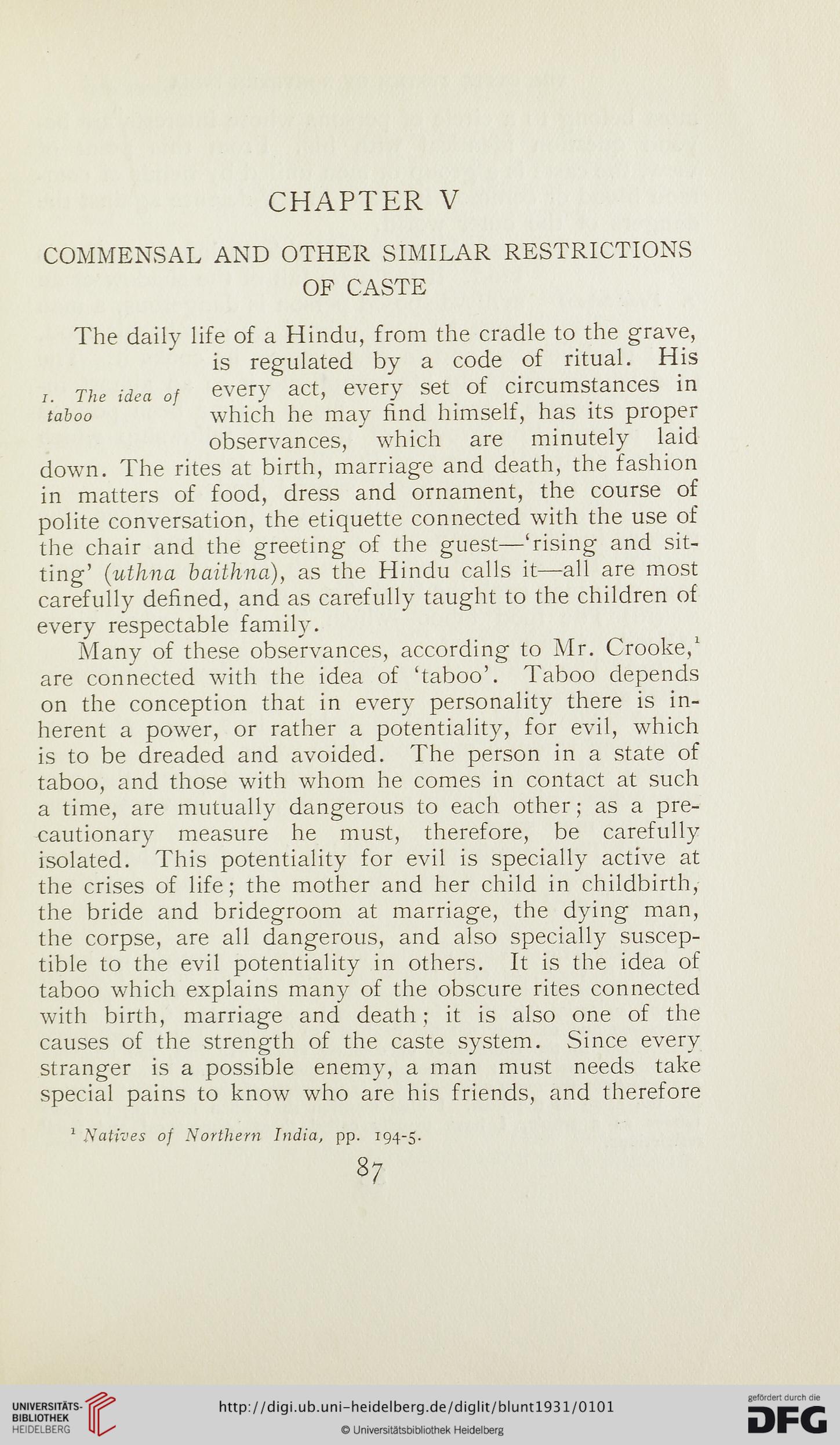CHAPTER V
COMMENSAL AND OTHER SIMILAR RESTRICTIONS
OF C-ASTE
The daily life of a Hindu, from the cradle to the grave,
is regulated by a code of ritual. His
i. The idea of every act, every set of circumstances in
tahoo which he may find himself, has its proper
observances, which are minutely laid
down. The rites at birth, marriage and death, the fashion
in matters of food, dress and ornament, the course of
polite conversation, the etiquette connected with the use of
the chair and the greeting of the guest—‘rising and sit-
ting’ (uthna baithna), as the Hindu calls it—all are most
carefully defined, and as carefully taught to the children of
every respectable family.
Many of these observances, according to Mr. Crooke,1
are connected with the idea of ‘taboo’. Taboo depends
on the conception that in every personality there is in-
herent a power, or rather a potentiality, for evil, which
is to be dreaded and avoided. The person in a state of
taboo, and those with whom he comes in contact at such
a time, are mutually dangerous to each other; as a pre-
cautionary measure he must, therefore, be carefully
isolated. This potentiality for evil is specially active at
the crises of life; the mother and her child in childbirth,
the bride and bridegroom at marriage, the dying man,
the corpse, are all dangerous, and also specially suscep-
tible to the evil potentiality in others. It is the idea of
taboo which explains many of the obscure rites connected
with birth, marriage and death; it is also one of the
causes of the strength of the caste system. Since every
stranger is a possible enemy, a man must needs take
special pains to know who are his friends, and therefore
1 Natives of Nortliern India, pp. 194-5.
87
COMMENSAL AND OTHER SIMILAR RESTRICTIONS
OF C-ASTE
The daily life of a Hindu, from the cradle to the grave,
is regulated by a code of ritual. His
i. The idea of every act, every set of circumstances in
tahoo which he may find himself, has its proper
observances, which are minutely laid
down. The rites at birth, marriage and death, the fashion
in matters of food, dress and ornament, the course of
polite conversation, the etiquette connected with the use of
the chair and the greeting of the guest—‘rising and sit-
ting’ (uthna baithna), as the Hindu calls it—all are most
carefully defined, and as carefully taught to the children of
every respectable family.
Many of these observances, according to Mr. Crooke,1
are connected with the idea of ‘taboo’. Taboo depends
on the conception that in every personality there is in-
herent a power, or rather a potentiality, for evil, which
is to be dreaded and avoided. The person in a state of
taboo, and those with whom he comes in contact at such
a time, are mutually dangerous to each other; as a pre-
cautionary measure he must, therefore, be carefully
isolated. This potentiality for evil is specially active at
the crises of life; the mother and her child in childbirth,
the bride and bridegroom at marriage, the dying man,
the corpse, are all dangerous, and also specially suscep-
tible to the evil potentiality in others. It is the idea of
taboo which explains many of the obscure rites connected
with birth, marriage and death; it is also one of the
causes of the strength of the caste system. Since every
stranger is a possible enemy, a man must needs take
special pains to know who are his friends, and therefore
1 Natives of Nortliern India, pp. 194-5.
87





